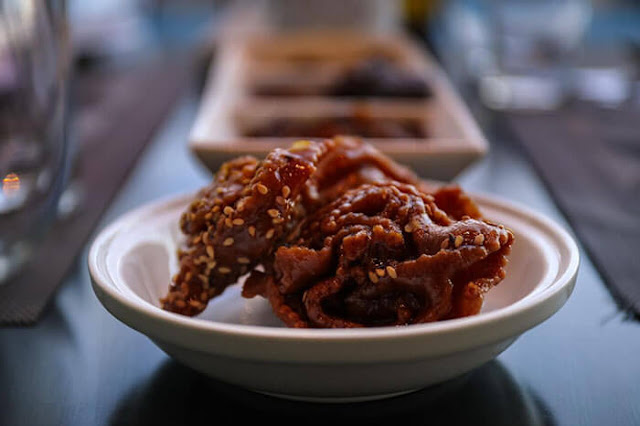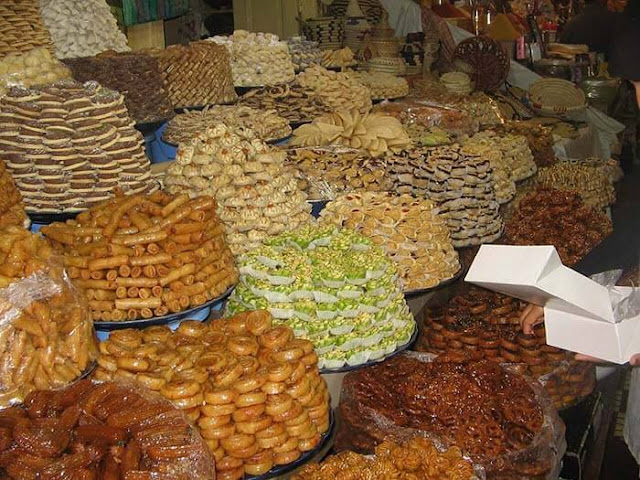Traditional Moroccan foods
Traditional Moroccan foods can boast one of the most exciting and exotic cuisines in the world, with influences derived from traditional Berber cooking, the Middle East, Andalusia, and France. In this post, we will highlight everything you should know and try about Moroccan foods …
15 FAMOUS TRADITIONAL MOROCCAN FOODS TO TRY WHILE VISITING MOROCCO
MOROCCAN APPETIZERS
HARIRA
The best-known Moroccan soups is harira, a thick, peppery broth made with lentils, chickpeas, mutton, and tomatoes, often thickened with rice, and flavored with lemon and tarragon. The dish is served traditionally in the evening during Ramadan to break the day’s fast. But you will find harira, it’s virtually a generic term for a thick soup, offered in restaurants all year round.
In this link you will find the authentic Moroccan soupes recipes included different types of Harira.
SALADE MAROCAINE (OR MOROCCAN SALAD)

A salade Marocaine (or Moroccan salad), it is an essential appetizing of traditional Moroccan foods. Is usually a very finely chopped mixture of tomato, onion, cucumber, and green pepper, in an oil and vinegar dressing, and flavored with fresh coriander. Merguez is spicy beef or lamb sausage.
Must Read: 15 Best Cities to Visit in Morocco
BROCHETTES AND KEFTA (MEATBALLS)

Other starters include brochettes, small cubes of lamb grilled on skewers. And Kefta, meatballs of minced lamb with cumin and coriander, cooked on a charcoal grill, too.
BRIOUATS

Briouats are small turnovers of thin pastry dough filled with kefta (spiced finely chopped meat), rice, almonds, sausage, or fish, a kind of Moroccan samosa. They are briefly deep-fried and served hot.
Related Post: How To Prepare Moroccan Khlii “Khlea” & Popular Recipes | Full Guide
RGHAIF

Rghaif though difficult to order because of their almost unpronounceable name, comprise a variety of fillings tucked within the folds of thin, fried pancakes and served hot.
MAIN COURSES, TRADITIONAL MOROCCAN FOODS
BSTILLA
Bstilla (bastela, pastilla) is a rich pigeon pie, a favorite local delicacy usually offered only in the more expensive restaurants because it takes a great deal of time and labor to prepare. First, the pigeons are cooked, and then the meat is spread in layers of paper-thin Ouarka (flaky pastry) along with saffron, almonds, cinnamon, and icing sugar. Baked to a delightful crispness, the finished pie is a rich, sweet, and delicious concoction.
COUSCOUS

It is virtually impossible to spend some time in Morocco without encountering the local staple, couscous. Is the famous traditional Moroccan foods! Couscous consists of a heap of steamed semolina grains topped with stewed vegetables and meat (lamb or chicken for the most part) and flavored with herbs and spices. If you prefer, you can ask for your couscous sans viande (without meat), although vegetarians should note that the vegetables have probably been cooked in meat stock.
Must Read: Authentic Moroccan Couscous Recipes | All You Need To Know
MÉCHOUI
You have only to wander into the hungry crowd at a moussem to encounter a Moroccan méchoui. The cook digs a pit, fills it with burning charcoal, and then spit-roasts a whole lamb over the glowing embers. Alternatively, you can enjoy lamb prepared in this way at the banquets organized for tourists in Tangier, Marrakech, and Agadir.
TAJINE, THE POPULAR TRADITIONAL MOROCCAN FOODS

In Morocco, a casserole or stew is called a Tajine, after the earthenware pot in which it is traditionally prepared. The best restaurants in Morocco will serve the dish in the pot! With its distinctive conical lid, though it is unlikely that the chef cooked it the traditional way by burying it within a charcoal fire in the ground. The usual ingredients are lamb or chicken with vegetables or fruit, such as prunes, dates, apricots, or lemon. You may see a Tajine made with fish, identified by the name hout Tajine on the menu. It is served with bread, which is used to mop up the delicious juices.
“”FRESH MOROCCAN BREAD IS SERVED WITH A FLOURISH IN UPMARKET RESTAURANTS.
MOROCCAN FISH AND SEAFOOD

Morocco’s long coastline and numerous lakes and streams provide a rich catch of fish for the Moroccan dishes. Red mullet, Dorado, Sardines, Sea bass, and Trout head the list. Fish can be used in a Tajine or Couscous but is more often grilled or poached and served alone as a main course.
Related Post: Moroccan cooking class | Things you must know before you start
Moroccan waters also yield a fine selection of fruits de mer (seafood), especially poulpe and calamar (octopus, squid), usually served deep-fried in a light batter. A popular delicacy is elvers (civelles), baby eels the size of matchsticks, sautéed in butter and garlic, and served with bread. You can enjoy eating Moroccan fish in several places, and cities, like Tangier, Essaouira, M’diq, Agadir, Asilah…
“”THE TAJINE IS A RICH STEW OF MEAT, VEGETABLES AND DRIED FRUIT COOKED IN AN EARTHENWARE POT.
MOROCCAN DESSERTS
When it comes to dessert, traditional Moroccan foods have a very sweet tooth. Honey is a major ingredient in many familiar desserts. Briouats, the little puffs of ultra-thin pastry described above as a starter, can also serve as a sweet when stuffed with honey and almonds.
GRIOUCHES (CHEBAKIA)

Griouches or Chebakia, twisted strips of honeyed pastry dough baked and sprinkled with sesame seeds, are popular as the last course at dinner and are also sold as a snack in the souks.
KAAB EL GHZAL

The best-known of the local after-dinner treats is kaab el ghzal, or cornes de gazelle, which means gazelle’s horns. These small horn-shaped pastries are filled with almond paste and flavored with orange-flower water.
Must Read: Things to know about Morocco country
STUFFED DATES
If you yourself have a really sweet tooth, search the menu for stuffed dates (dattes farcies). The classic recipe calls for the best quality dates, stuffed with a paste of ground toasted almonds, sugar, and orange-flower water.
Fresh fruit is often served to round off the meal – succulent melon, figs, oranges, peaches, dates, and apricots.
MOROCCAN DRINKS
MINT TEA IS THE MOST FAMOUS TRADITIONAL MOROCCAN FOODS

Morocco’s national drink is mint tea, or thé à la Menthe, a delicious and refreshing drink made from an infusion of green tea with sprigs of fresh mint, and well sweetened with sugar. It is usually served in small, tulip-shaped glasses. (Tea was introduced to Morocco by British merchants in the 19th century.)
A visit to a Moroccan home wouldn’t be complete without the friendly ritual of the tea-making ceremony. The honor usually falls to an important guest.
COFFEE
Coffee is available in all French-style cafés and is usually served strong, black, and sweet (café noir). If you want a little milk added to the brew, ask for café cassé, or café au lait for a lot of milk.
Mineral water (eau minérale) is available in all restaurants, either still (non gazeuse) or sparkling (gazeuse).
Prices of most drinks are moderate; particularly mineral water, mint tea, and soft drinks, but imported wine and spirits are relatively expensive and can add considerably to the bill.
WHERE TO EAT TRADITIONAL MOROCCAN FOODS
Eating places in Morocco can be divided into four categories.
BASIC RESTAURANT AND FRENCH-STYLE CAFÉS
First, there is the basic café-restaurant aimed mainly at local people, usually found in the Medina and often a hole-in-the-wall type place with tables out on the pavement. It serves cheap, solid fare such as kebabs, sausage, soup, salad, and bread, at very low prices.

Then there are the French-style cafés and patisseries (pastries) found in the villes Nouvelles (new city) of the larger cities. Where you can enjoy a croissant, cake or pastry washed down with coffee, mint tea, or fruit juice.
MIDDLE & TOP-RANGE RESTAURANTS OF TRADITIONAL MOROCCAN FOODS

The most popular places with travelers tend to be the middle-range restaurants offering a mix of traditional Moroccan foods and French dishes. This category includes the seafood restaurants on the coast, and the Italian, Chinese Vietnamese, and other international restaurants found in the larger cities.
Top of the range in terms of price and setting are the palatial establishments advertised as ‘traditional Moroccan restaurants’. These are usually housed in converted mansions in the Medinas of Marrakech, Fez, and Meknes. Offer banquet-type meals accompanied by a floor show of folk music and dancing. Advance reservations are essential to these places.
MOROCCAN MEAL TIMES
MOROCCAN BREAKFAST
A traditional Moroccan breakfast consists of mint tea or coffee with bread and jam or honey, and perhaps a hard-boiled egg or some cheese and a handful of olives. City-bred Moroccans begin their day the French way, with coffee and croissants or other pastries. In a hotel, the standard ‘tourist’ breakfast often consists of a croissant or roll, jam, and butter, with coffee, tea, or hot chocolate, and is served between 7 and 9 am.
MOROCCAN LUNCH AND DINNER
Lunch is served between noon and 3 pm, and dinner between about 7 and 9 pm. A formal Moroccan-style evening meal at one of the expensive Medina restaurants (described above), is likely to consist of soup or salad followed by two main courses! Often Bstilla and couscous, and rounded off with a dessert of fresh fruits and pastries.


